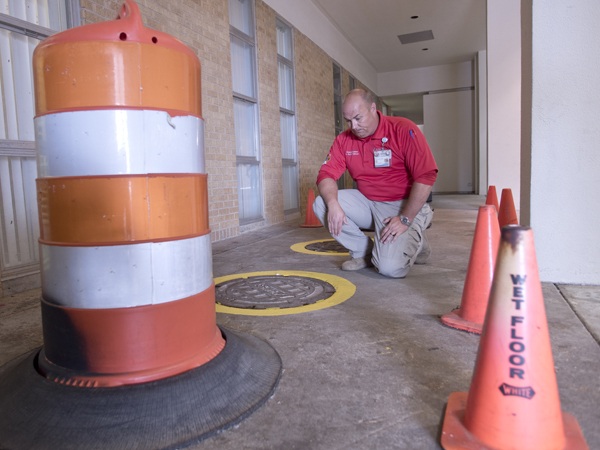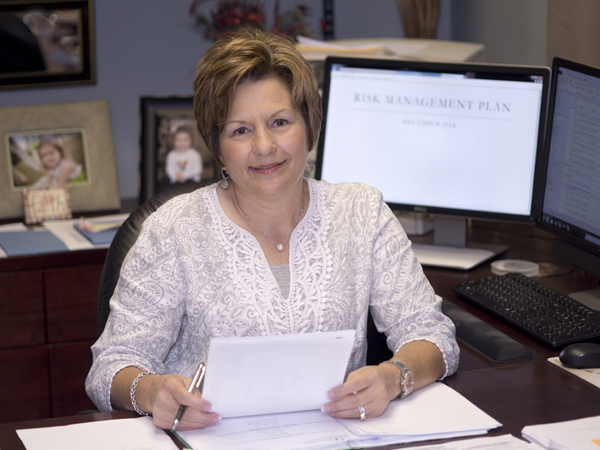Don’t fall prey to slips and trips

Darlene Bryant did everything right - and she still fell down.
It had been raining the day she took the shuttle bus to campus. “I had my umbrella, and I was getting off the bus. I was holding onto the rail. I had on flat shoes. I wasn't on my phone,” remembered Bryant, the Medical Center's director of risk management.
“I got to the second step, and next thing I know, I'm on the street,” Bryant said. “I landed first with my back against the steps of the bus. The driver on the bus ran down to me, and the people on the street were standing around, asking if they could help me.
“I wanted to make sure I could breathe. It had knocked the breath out of me,” Bryant said. “I got up and walked to the office.”
She became what people would rather not be: a safety statistic. In 2015, the Medical Center recorded 117 employee slips, trips and falls “all committed in the act of walking,” said Donnie Denton, supervisor and senior safety officer in Environmental Health and Safety.

Another 23 falls -- among them Bryant's tumble -- happened for other reasons, including employees' chairs rolling out from under them or a health condition that made an employee woozy or lose their balance, Denton said.
The total falls for 2015 cost UMMC $1.2 million, averaging $10,516 per person. “Usually, they occur because people are being inattentive while walking on an uneven surface or near an object or spill,” Denton said. The highest number of falls, 20, was recorded in September; the low was five, in November.
But combine that with use of a cell phone, and no wonder the national statistics on falls are so high. Between 2005-10, there was a 589 percent increase nationally in visits to emergency rooms related to distracted walking, Denton said.
He's found that falls on the Medical Center campus experienced by employees on their cell phones often have nothing to do with an uneven surface or something on the floor, such as a spill or an object. Instead, it's all about inattention. “I encourage the 'heads up, phone down' scenario,” Denton said.
Part of the $1.2 million cost is attributed to lost work time. Bryant, who filled out an employee injury report the day of her spill, ended up staying home for about a week.
“I couldn't sleep or get comfortable. I was hurting so bad I couldn't breathe,” she said of the two days that followed her fall. She went to Student and Employee Health; that office sent her to the Emergency Department, where she was diagnosed with broken ribs in her back from hitting the bus steps. Doctors' orders were a week at home on muscle relaxers and pain medications.
Ways to prevent many slips, trips and falls are simple, but employees often fail to put them into action. The most needed, and most ignored: Pay attention.
“There are some things that can't be helped. People step off a bus, and they turn their ankle,” Denton said. “But overall, we're not watching where we're going.”
He urges employees to take the time to watch for uneven surfaces, pick up objects off the floor, and report spills that need cleaning. “We may not be able to clean it up, but we need to report it,” Denton said.
“If there's a restroom nearby, take tissue and put it on the spot. At least that identifies it for someone who is walking by so that they don't slip and fall,” he said. “And a lot of people don't know who to call. The number is 601-984-1420, 24 hours a day. If it's a spill or anything that housekeeping or physical facilities would be in charge of, they will dispatch someone to address it.”
Employees who experience an injury on the job -- including those sustained as part of a slip, trip or fall -- are asked to report it to their manager and fill out an employee injury report accessible from Medical Center desktop computers, said Barbara Smith, director of employee relations in the Department of Human Resources. On the report, employees are asked to give input on how an injury occurred and unsafe conditions that may have contributed to it.
“If you fall, even though you believe you're not hurt, you must file a report,” she said. “You might not feel like you're hurt that badly, but tomorrow, you may not feel well.”

Anyone injured on campus can go to Student and Employee Health, the Emergency Department, or the physician of their choice, Smith said. Employee injury reports will be forwarded to the Workers Compensation specialist in HR, and an investigation will determine whether an employee qualifies for those benefits, she said.
In February, library director Susan Clark took an unexpected fall in a campus parking lot on her way into work. Fortunately, she wasn't injured, and other employees were nearby to check to see that she was OK.
She walked on some loose gravel, “and I just went down,” Clark said. “I wasn't hurt, but since it was a fall, you have to go through the protocol.” Clark also contacted Denton, who checked the spot where she fell.
Clark said it changed how observant she is. “You're more careful and notice where the pavement is uneven in places you walk past day after day,” she said.
Denton's office reviews all injury reports, and “we address anything that is a deficiency as quickly as possible. We like to do it proactively. I do annual sidewalk assessments, and if there are any raised areas, we address them.”
A couple of examples: Denton and physical facilities place abrasive materials on sidewalks or surfaces in locations that can be slippery, such as the new sidewalk area that runs across the side of the student union and down the side of the new School of Medicine construction.
Denton also directed crews in evaluating two sewer manholes in a small, former smoking area between Batson Children's Hospital and Methodist Rehabilitation Center. Several falls have been recorded there caused when people tripped over the manholes, which jutted up and weren't level with the pavement.
“Physical facilities pulled them up and reset the lids, but they still stuck up,” Denton said. “We painted a yellow circle around each lid and blocked them with cones.” Crews will come back soon to build a barricade that directs traffic away from them, he said.
The Medical Center's goal is to reduce slips, trips and falls by 25 percent during 2016, and employees are on track to do it. In the first five months of this year, falls were down from 2015 in February, April and May, the same in January, and up in March.
“We're not where we need to be until we reach our ultimate goal, but we're on the right path,” Denton said.
It was a little embarrassing to take a tumble, Bryant said, seeing that she directs the Medical Center's risk management. “I wish I could say it was a ski accident,” she said.
“I'm fine now. But I was so aggravated, because I did everything right.”


